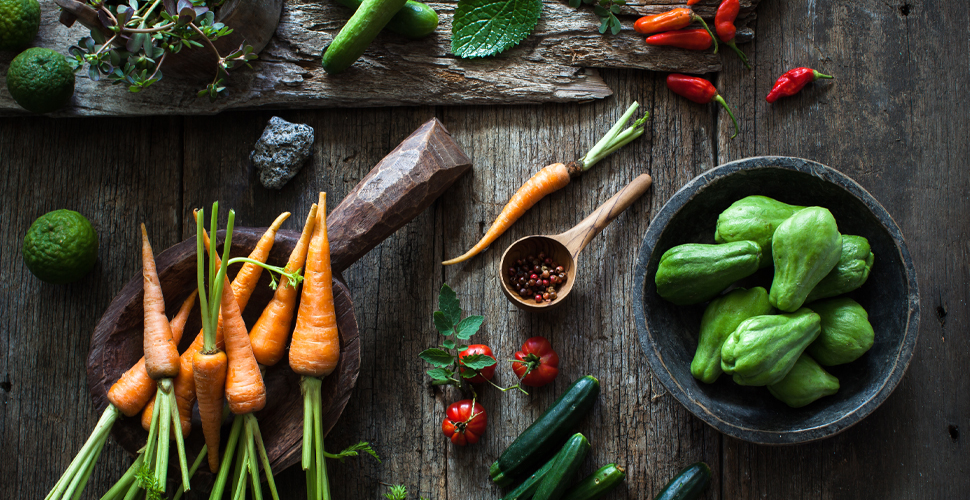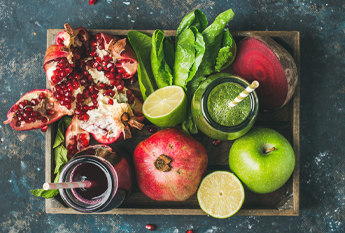The Health and Environmental Benefits of Seasonal Eating
The human body has a magnificent mechanism in perfect harmony with nature. The key to this impeccable mechanism is the food we consume. From amino acids making up our cells to the vitamins that ensure the proper functioning of hormones, to minerals that deliver brain’s messages to the relevant systems, and to the nutritional components that energize our metabolic activities, the body needs food to sustain basic life functions.
We all want a healthy and balanced diet to protect and boost our holistic health, and to provide for our body’s needs through food. However, the needs and functions of our body constantly fluctuate in line with the natural bodily changes. During the heat of summer, for instance, our body requires more water and we feel the need for water-rich food. Conversely, on cold winter days we long for food that will boost our immune system and help protect our body heat.
What Is Seasonal Eating?
Humans are an intrinsic element of the ecological balance and rely on nature to survive, as do all other creatures. Through thousands of years of evolution, our bodies reached their current build and are programmed to a biological rhythm in harmony with the changes and cycles in nature. It was relatively easier in the past to follow this biological rhythm, which encompasses our entire metabolic activities. Today, our biological rhythm is challenged by many environmental factors, including long hours at the work desk, the consuming of processed food seasoned with preservatives and chemicals, and eating food not grown in our region. Moreover, advancing technology and industrialization in the 21st century brought upon radical changes to our way of sowing, producing, processing, and consuming food that further distances us from the natural way of eating.
As our lifestyle and diet lose touch with the cycle of nature, both our physical health and the balance of ecosystem deteriorate with the rapid depletion of natural resources, environmental pollution, and the weakening overall health of our planet. Seasonal eating refers to the consumption of foods that grow in our geographic region and in the flow of nature following seasonal changes. In other words, it refers to the consumption of fruits and vegetables locally produced in the correct seasons to thrive with the countless benefits for our health and the environment.
Benefits of Seasonal Eating
Products in season grow completely naturally without the need for environmental arrangements, harmful chemicals, pesticides, or maturing agents. It is therefore as beneficial for our health as it is for the soil, air, and water to prefer these products in our diet.
Enhances Holistic Health
- All foods grown naturally in the correct season contain nutritional elements that are particularly beneficial for the human body during the season and in that environment. Winter fruits such as carrot, pumpkin, and citrus, for instance, are rich in vitamins including A and C, which strengthen the immune system. On the other hand, summer fruits and vegetables such as watermelon, cucumber, and courgette contain high amounts of water to respond to our body’s increasing need for water.
Strengthens the Immune System
- Seasonal fruits and vegetables sun-ripened and timely harvested to be consumed without delay are substantially richer in antioxidants, nutrients, and healthy bacteria (probiotics) compared to produce harvested before ripening to prevent decay and filled with preservative chemicals to survive the thousands of kilometers to our tables. While healthy intestinal flora, the keystone to the immune system, depends on healthy gut bacteria, the preservatives and chemicals in many food consumed out of season harm these healthy bacteria in the gut flora, thus upsetting the balance and weakening the immune system. Seasonal produce are rich in fiber to support intestinal health and rich in antioxidants, vitamins, and minerals to strengthen the immune system.
Supports Small and Local Producers to Contribute to the Local Economy
- Today, all fruits and vegetables are available at supermarkets, greengrocers, and even at produce markets in and out of season throughout the year. However, these fruits and vegetables are often produced in several large greenhouses and industrial farms that provide the suitable growth conditions. This means that each piece of produce you purchase out of season supports not the local producers and small enterprises but the industrial agricultural companies that mass produce using pesticides, harvest before ripening, and focus on quantity over quality. As the produce ripened in season tend to spoil rapidly during long-distance transportation, they are often purchased from nearby farms and local producers. This shift in source subsequently helps support small enterprises and provides us with food richer in nutrients.
Economical and Budget-Friendly
- Seasonal fruits and vegetables require no outside sources to grow. They have everything they need in the heat, humidity, and sunshine of the season, and ripen on their own without the need for human-induced additives. They are low-cost in production and logistics, meaning they are more affordable and more beneficial to your health and the health of the planet.
Substantially Reduces Carbon Emissions
- The arduous journey produce takes to our tables deprives us of essential nutrients, exposes us to diseases through the introduction of toxic elements into our bodies, and releases significant amounts of greenhouse gases into the atmosphere. The longer the journey, the more fossil fuel is used and the more carbon dioxide emitted. In this respect, tropical fruits and vegetables are particularly egregious as they are transported by air, compounding the amount of carbon emissions. Seasonal eating not only reduces carbon dioxide emissions, a major driver of climate change, but also contributes towards a more sustainable future by reducing the use of natural resources and decreasing pollution.
Suggestions to Ease into Seasonal Eating
- Do not consume any food out of season. Find out more about methods of preservation such as making jams and pickles, or drying or freezing to enjoy your favorite short-season fruits and vegetables, such as strawberries, cherries, sour cherries, capia peppers, cabbages, and lady’s fingers, even when out of season.
- When shopping for fruits and vegetables, opt for neighborhood greengrocers or local produce markets instead of supermarkets. Make sure to find out about the source, storage conditions, and the use of pesticides or hormones when purchasing food. If possible, explore smaller orchards or farms nearby to purchase fruits and vegetables directly from the producer.
- Grow your own food. You can easily grow various fruits and vegetables, including strawberries, tomatoes, cucumbers, peppers, eggplants, scallions, green garlics, cabbages, chards, green beans, and potatoes, in your garden or in pots on your balcony to enjoy them when they thrive in season.
Seasonal Fruits and Vegetables to Enjoy in Autumn or Winter
September – Vegetables: Courgettes, tomatoes, lady’s fingers, eggplants, celery, peppers, bell peppers, cucumbers, green beans, corn. Fruits: Watermelon, melons, avocados, apples, pomegranates, figs, bananas.
October – Vegetables: Cabbages, cauliflowers, carrots, mushrooms, radishes, spinach, leeks. Fruits: Apples, tangerines, pears, pomegranates, grapes, grapefruit, lemons.
November – Vegetables: Beets, chards, celery, cauliflower, potatoes, radish, leeks, spinach, carrots, cabbages, Jerusalem artichokes. Fruits: Tangerines, pomegranates, bananas, kiwi fruits, apples, pears, grapefruits.
December – Vegetables: Beets, chards, potatoes, carrots, leek, radishes, spinach, celery, black cabbages, red cabbages, Brussels sprouts, cabbages, cauliflowers, blessed thistle, Jerusalem artichokes. Fruits: Tangerines, pears, apples, bananas, pumpkin, kiwi fruits, pomegranates, medlars, lemons, chestnuts, grapefruits.
January – Vegetables: Beets, broccoli, potatoes, chards, leeks, radishes, spinach, turnips, sheep’s sorrel, Jerusalem artichokes, cabbages, celery, cauliflower, blessed thistle, pumpkin. Fruits: Bananas, grapefruits, quinces, pears, apples, chestnuts, lemons, kiwi fruits, oranges, kumquats.
February – Vegetables: Beets, turnips, broccoli, potatoes, leeks, spinach, cauliflowers, cabbages, Jerusalem artichokes, blessed thistle, pumpkin, carrots, radishes, celery. Fruits: Quinces, oranges, kiwi fruits, apples, bananas, lemons, pears, grapefruits, pomelos, kumquats.
Remember to explore the natural and healthy seasonal delights of the Beautyfood Menu, which indulges guests with natural ingredients while they are enjoying their stay at Richmond Nua. Beautyfood Menu dishes are appetizing, delicious, healthy and balanced thanks to their natural ingredients and cooking techniques.







